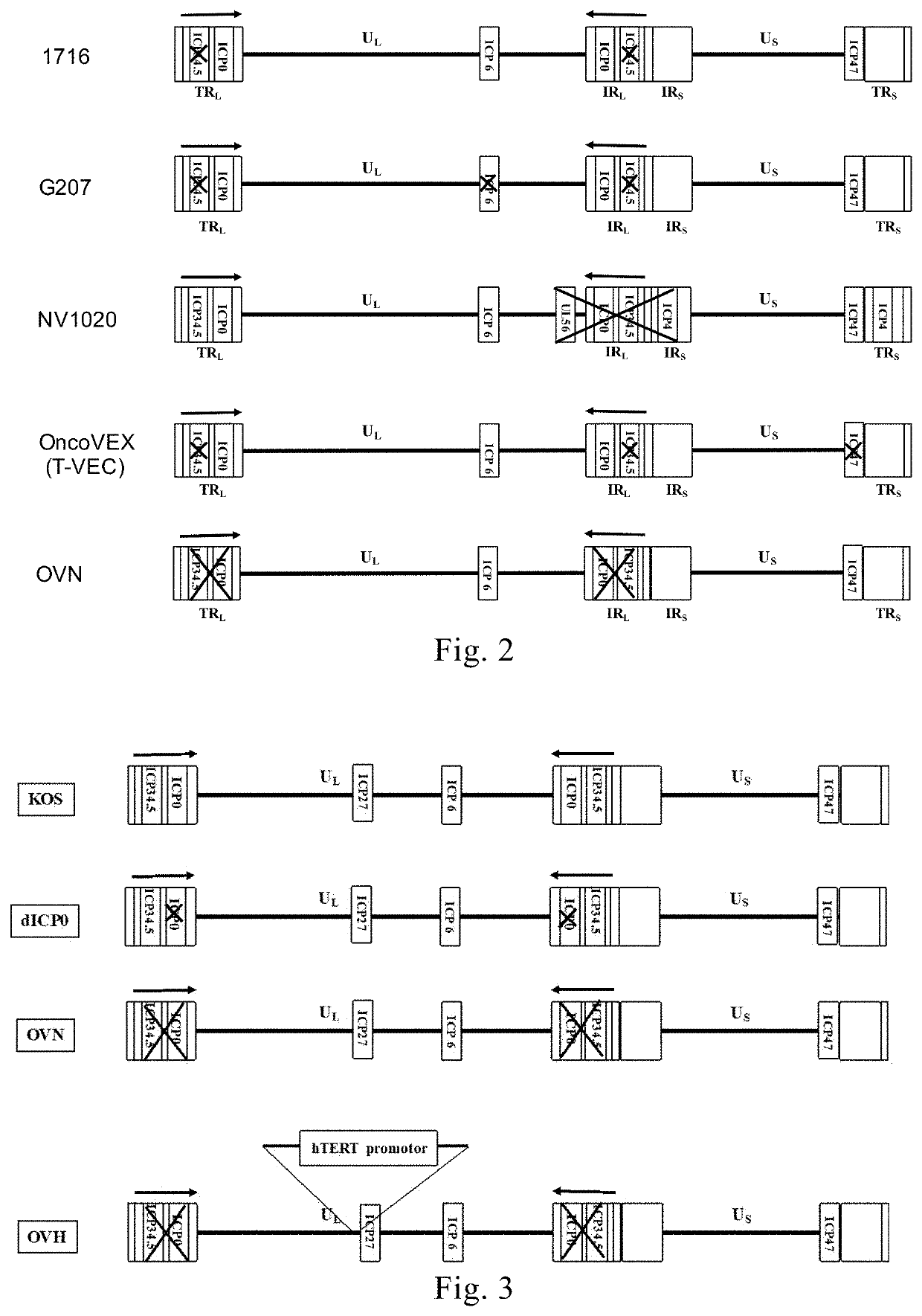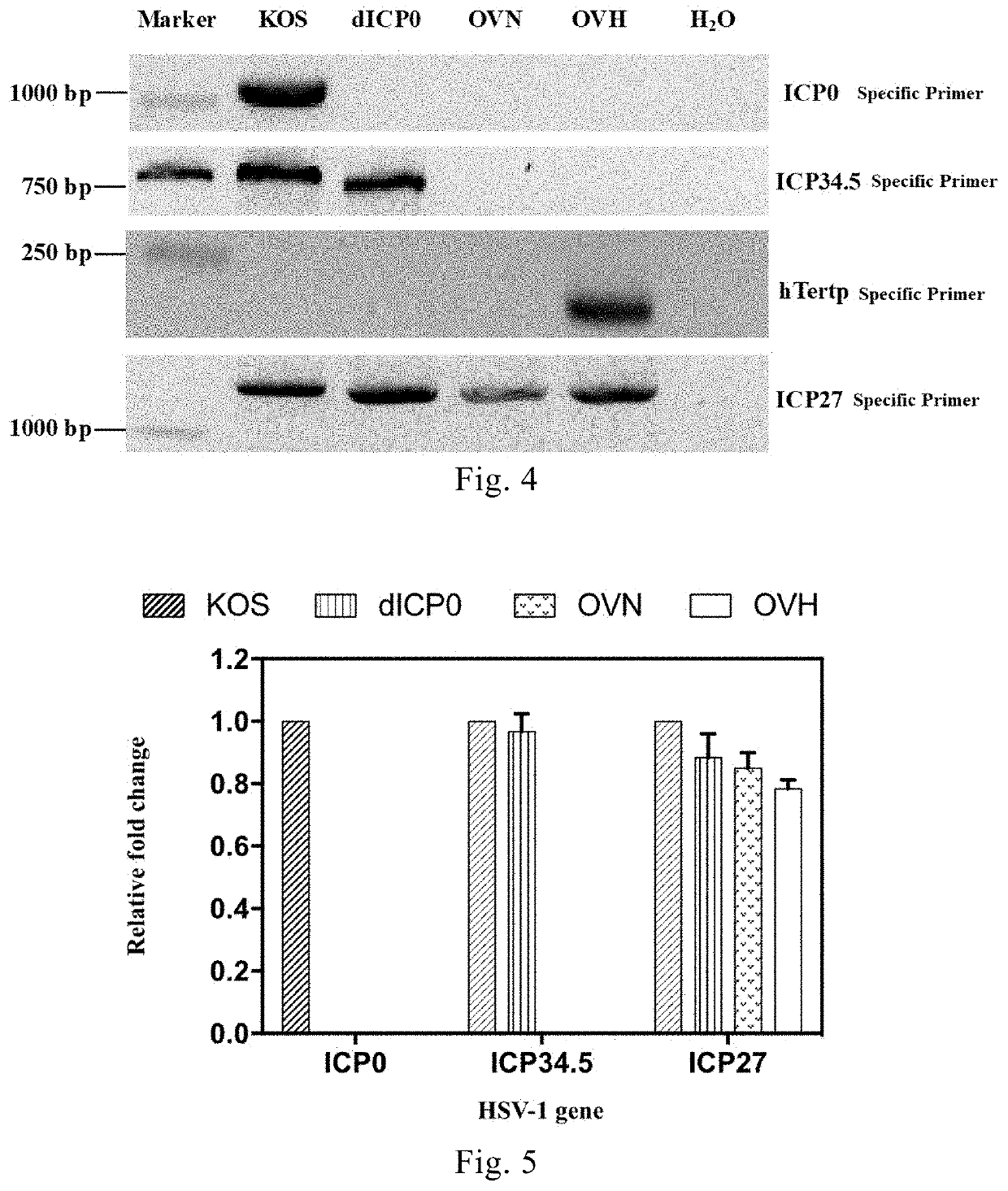Recombinant herpes simplex virus and use thereof
a technology of herpes simplex and recombinant herpes simplex, which is applied in the field of virology and tumor therapy, can solve the problems of large side effects, inability to complete treatment, and prone to drug resistan
- Summary
- Abstract
- Description
- Claims
- Application Information
AI Technical Summary
Benefits of technology
Problems solved by technology
Method used
Image
Examples
example 2
ization of Recombinant Viruses OVN and OVH
[0191]The recombinant virus dICP0 was constructed with reference to the method described in Example 1, which had the deletion of two copies of the ICP0 gene as compared to the strain KOS. The virus strain KOS and the recombinant virus dICP0 were used as control viruses to characterize the recombinant viruses OVN and OVH. FIG. 3 is a schematic illustration of the genome modifications comprised in the recombinant viruses OVN, OVH and dICP0 compared to the virus strain KOS; wherein the recombinant virus dICP0 had the deletion of two copies of the ICP0 gene compared to the virus strain KOS; the recombinant virus OVN had the deletion of the two copies of the ICP34.5 gene and the two copies of the ICP0 gene; the recombinant virus OVH had the deletion of the two copies of the ICP34.5 gene and the two copies of the ICP0 gene, and the native promoter of the ICP27 gene was substituted with the hTERT core promoter.
[0192]The gene deletions in the recomb...
example 3
n of Replication Ability and Killing Ability of Recombinant Virus OVN / OVH
[0197]Normal cells (L-O2 cells) and tumor cells (U-2 OS cells) in logarithmic growth phase were seeded in 6 cm culture plates at a density of 5-7.5×106 cells / plate. Subsequently, the cultured cells were infected with the virus KOS, OVN, OVH or dICP0 at a MOI of 1. After 48 hours of infection, the state of the cells was observed under a microscope and photographed. Subsequently, the virus-infected cells were digested, and the survival rate of the cells was calculated by trypan blue staining. Cell survival rate (%)=(number of viable cells after infection with virus) / (number of control cells not infected with virus)×100. A 3-well replicate was set for each group of experiments and the experimental result was the average of 3 independent experiments. In addition, the virus titers at different time points after infection of normal cells (L-O2 cells) and tumor cells (U-2 OS cells) with virus KOS, OVN, OVH or dICP0 we...
example 4
n of Neurotoxicity and In Vivo Safety of Recombinant Virus OVN / OVH
[0204]Herpes viruses are neurotoxic and neurologically latent, with the greatest danger being the ability to infect the central nervous system of humans or animals, leading to serious side effects such as encephalitis. Therefore, the most direct and sensitive way to assess the safety of herpes viruses is to inject the virus intracranially into young mice and assess the direct killing of the mouse central nervous system by the virus. In this example, we evaluated the neurotoxicity and safety of various recombinant HSV-1 viruses in mice using a mouse encephalitis model induced by intracranial injection of virus.
[0205]Briefly, 4-6 weeks old BALB / c female mice (n=10) were used as experimental subjects, and 20 μl of virus was slowly injected intracranially at the left anterior lobe of brain, near the junction of coronal suture and sagittal suture. After the injection, the incidence and survival of the mice were observed ev...
PUM
| Property | Measurement | Unit |
|---|---|---|
| Volume | aaaaa | aaaaa |
| Volume | aaaaa | aaaaa |
| Fraction | aaaaa | aaaaa |
Abstract
Description
Claims
Application Information
 Login to View More
Login to View More - R&D
- Intellectual Property
- Life Sciences
- Materials
- Tech Scout
- Unparalleled Data Quality
- Higher Quality Content
- 60% Fewer Hallucinations
Browse by: Latest US Patents, China's latest patents, Technical Efficacy Thesaurus, Application Domain, Technology Topic, Popular Technical Reports.
© 2025 PatSnap. All rights reserved.Legal|Privacy policy|Modern Slavery Act Transparency Statement|Sitemap|About US| Contact US: help@patsnap.com



